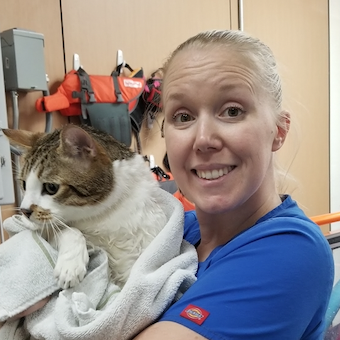People must come first.
More than a do-good, feel-good philosophy — prioritizing people seriously helps your bottom line. Companies with engaged employees have customer loyalty rates 233% higher than those that don’t. These companies with healthier culture also see a significant lift in revenue compared to their unhealthy counterparts.
These people-first employers also have better employee retention. This stuff’s pretty important - 66% of employees say culture is their number one factor in deciding whether to stay in a job.
Prioritizing people, purpose, and progress is a winning strategy, with highly-engaged teams outperforming others by a whopping 147%.
We must prioritize our people over patients and profits. Wait, what?
It might feel weird to hear, but prioritizing patient care and profits before people will damage patient care and profits in the long term. Struggling (or understaffed) teams can’t provide the best patient care and certainly can’t drive business growth.
People-first businesses see better client satisfaction, better patient care, and greater revenue. These businesses also cut costs and decompress their margins by saving significant costs on recruiting, hiring, and training by retaining and upskilling their existing employees.
The best veterinary practices care deeply about client and patient care and have strong strategies in place to achieve healthy business performance. You will also find these businesses put their people first.
Prioritize and empower your people, and watch them supercharge your business.
4 Steps to Prioritizing Your People
1. Bring your people together
To prioritize people, you must align to a shared, meaningful purpose. It must be clear to everyone that you are intentional in your HR strategy, and that you firmly believe that people must come first.
This should be reflected in your core values and throughout the entire employee experience you craft. Practices who prioritize people place immense focus on culture and employee experience.
Some unlearning and relearning might be needed to get here. In a profession hyper focused on patients and clients, we must realize - they do not come first.
Patients do not come first. Clients do not come first. Dollars do not come first.
Your people come first.
Without healthy, engaged, collaborative team members, your practice can not provide excellent patient care, and will surely not have the energy to go above and beyond to provide an excellent customer experience.
However, if you look closely at any leader in excellent performance and customer experience, you will find one constant. Their people are prioritized.
Excellent patient and client experience is delivered by teams with a strong sense of togetherness. To achieve this, you must build the 4 core pillars of culture in your practice: purpose, safety, vulnerability, and growth.
2. Compensate your people better.
Economically secure employees are healthier, more productive employees — it’s that simple. Market dynamics have also shifted, and an “employer’s market” is a thing of the past. Talent is the most valuable resource in veterinary medicine. Employees have options and will be magnetized by employers with leading culture and compensation.
Compensation goes further than just a paycheck every two weeks. Offering an array of quality benefits also helps attract and retain excellent team members.
Not sure what to pay your people?
Here’s what leading veterinary industry employers are paying their veterinary teams:
- Receptionists and Assistants: $15/hr +
- Technicians: $20/hr +
- Practice Managers: $70k/yr +
- DVMs: $100k/yr +
Not sure what types of benefits to offer?
Here’s what the best are offering:
- Healthcare, Vision, Dental, Therapy
- 401K, 4% match
- 529 Plans
- Pet Insurance
- Sign-on bonuses (for any team member)
- Generous PTO
- CE Reimbursement
- Tuition Reimbursement
- Profit-Sharing
- Parental Leave
- Mentorship/Sponsorship Programs
3. Punt the skunks. 🦨
This “hound habit” is part of hound’s culture code. Skunks spray “negativity” onto others, and eventually, everyone starts stinking. We must protect each other and our cultures at all costs. Don't let your practice get stanky.
That goes for team members and clients. If team members are toxic or constantly negative, coach them directly and privately to understand what may be going on. If you can’t come to a resolution, it’s time to part ways.
Same for clients. If they are rude or abusive to your team, they’ve gotta go. There is no client or employee worth keeping around if they are hurting your people and culture.
*No real skunks are harmed by hound. Please don’t actually punt real skunks. That won’t solve your culture troubles.
4. Gather feedback and grow together.
Prioritizing your people also means listening and gathering feedback from them constantly. To ensure your people are happy, healthy, and supported, you must stay in tune with what’s working and what isn’t.
From real-time feedback to one-on-ones, surveys, and employee health scoring, you should take every opportunity you have to take a pulse on your people. And you must be prepared to accept that you need to change some things.
Take the time to set goals together, strengthen weaknesses, empower people to do the things they love, and constantly improve.
Vulnerability and Growth are two core pillars in building and sustaining healthy culture. Without them, you’ll limit the abilities of yourself, your teams, and your practice.
Want to explore more practical tips?
Check out the section on purpose-building in The Ultimate Guide for Awesome Culture in Veterinary Medicine.
Want to share some of your favorite practical tips?
Collaborate on an article with us! (Email sara@hound.vet for details.)
From the Experts
Thank you so much to our collaborators! Here’s their take on the importance of prioritizing people, purpose, and progress.
From Brennan McEachran, CEO @ Hypercontext:
"When you lead by example in a manner that drives business results without the expense on the 'life' part of work-life balance.
At Hypercontext, we do this by:
1. Being hyper-focused on ensuring expectations and goals are clear. We understand where we need to go, but it’s up to the team to figure out the best way to get there. This drives a stronger sense of purpose and ownership across the team. This also makes it easier to visualize progress towards those goals!
2. We also put in a lot of work when it comes to building trust across the company, ensuring that psychological safety is a top priority across all leaders and their teams."
From Paul Spiegelman, Author of Patients Come Second:
"Just like those who work in human healthcare, those in veterinary medicine come with a heart for service.
To take care of those we serve, we need to take care of each other first.
Our organizations exist to enhance the lives of the people that work in them. If that’s our first priority, everything else will follow."
From Andrew Luna, CEO @ hound:
"Veterinary Medicine is a profession of people incredibly impassioned to care. To care for animals, nature, and science. But we must also care for one another.
In this profession, it is easy to lose sight of oneself & each other and place all emphasis on the care of patients and clients. But that care is not delivered by magic. It is delivered by people, and we must ensure that those people who care for us and our beloved pets are themselves healthy and growing.
By prioritizing people, purpose, and progress in veterinary medicine, we will witness amazing things. Individuals will become a galvanized collective, delivery of care will be swift and effective, clients will rave and return, and our businesses will thrive. We will also see the effects ripple beyond veterinary practices.
People do not exist as employees and clients within the walls of our practices. Holistically, the picture is much bigger than that, and prioritizing your people brings profound effects. Your people will be happier and healthier, impacting the lives of their families, neighborhoods, greater communities, and generations to come. That is the power of putting people first."






.gif)


